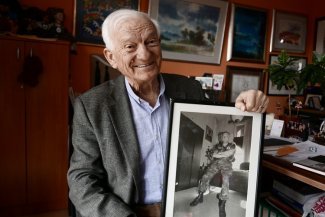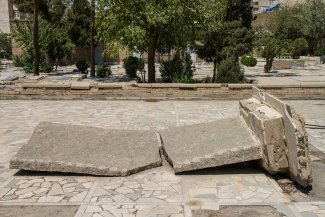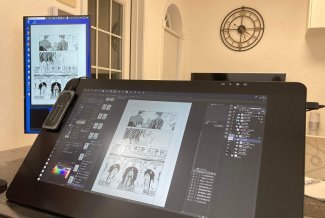Monument to the Revolution of the People of Moslavina at Podgarić, Croatia, designed by Dušan Džamonja and erected in 1967. This site commemorates a local uprising against the Ustaše, the Croatian fascist movement that nominally ruled the Independent State of Croatia during the Second World War.
By day, 37-year-old Donald Niebyl is a biologist working on the protection of wildlife in Illinois, United States. By night, he is a researcher of anti-fascist memorials in the former Socialist Federal Republic of Yugoslavia. It’s an unusual hobby that started when Niebyl decided to track down some of the monuments during a 2016 trip to the Balkans. Ever since, documenting spomeniks (which means ‘monuments’ in Bosnian-Croatian-Montenegrin-Serbian) has become one of his main preoccupations. “As soon as I began to see photos of [spomeniks] on the internet, I became highly intrigued by them and wanted to know more about them: what they meant, why they were built and what set of circumstances led to their construction,” Niebyl tells Equal Times.
With his Spomenik Database, a comprehensive online platform about monument building in the former Yugoslavia launched two years ago, an interactive map of around 100 monument locations, and a book Spomenik Monument Database coming out this September, Niebyl has become a renowned expert on Yugoslav memorials.
But he is not the only one who is fascinated by the abstract structures of Josip Broz Tito’s Yugoslavia.
An increasing number of people are showing an interest in the mammoth concrete and steel structures dotted around the countries of the former Yugoslavia, which one Guardian journalist said “look like alien landings, crop circles or Pink Floyd album covers.” According to Niebyl: “The thing that attracted me to the monuments was, as is the case for most people, their highly imaginative and universalist design approaches.”
There are websites, blogs and photo projects dedicated to the subject and guided tours for international travellers who want to see them up close. “Foreigners find it attractive to approach communist monuments as archaeologists who discover some lost civilization,” says Serbian sociologist Dario Hajrić who wrote about the phenomenon of ‘Yugo-nostalgia’ in the former Yugoslavia. Later this month, Toward a Concrete Utopia: Architecture in Yugoslavia, 1948–1980 will open at the world-famous Museum of Modern Art Museum (MoMA) in New York, exhibiting drawings, models and photos of some of the most notable buildings and urban planning created during the communist era.
Concrete controversy
Initially, the monuments were commissioned by Tito and local war veteran groups to commemorate victims of the Second World War and to celebrate the new socialist state. Some of the later monuments referred to earlier events such as the Illinden Memorial at Kruševo in the (still) Former Yugoslav Republic of Yugoslavia (eventually Republic of Northern Macedonia), which commemorates not only the 1903 Ilinden Uprising against the Ottoman Empire, but also the Partisan fighters, the communist-led resistance to the Axis powers during the Second World War led by Tito.
According to text from Niebyl’s Spomenik Database: “At the outset of Tito’s new Republic (established from the ashes of that revolution), ambitious plans were laid to craft something new, something brave and adventurous – a classless country ruled by principles of socialism, a population free of ethnic tension, all bound together by feelings of ‘brotherhood and unity’... and Yugoslavia’s ‘spomenik project’ was a part of that grand plan.”
Some of the monuments were built by the most prominent Yugoslav architects and sculptors of the day, such as Dušan Džamonja, Vojin Bakić, Bogdan Bogdanović and Ljubomir Denković, who designed giant constructions depicting fists, flowers, stars or wings symbolising the anti-fascist struggle. Erected in woods, fields and hillsides far away from urban zones, the constructions look like they fell from the sky.
CNN may have listed spomeniks amongst the “world’s ugliest monuments”, but admirers say that the contrast between the structures and their surrounding landscapes give them a mysterious appeal.
But following the violent break-up of the former Yugoslavia in the early 1990s, people began to view the statues as an unwanted reminder of their communist past. The 30-metre-high Monument to the Victory of the People of Slavonia in Kamenska, Croatia, designed by sculptor Vojin Bakić and erected in 1968, was the world’s largest post-modern sculpture until it was blown up and destroyed by the Croatian Army during the Croatian war for independence in 1991. Hundreds of other structures were purposefully destroyed, while others were simply neglected and abandoned. In some regions of the former Yugoslavia, however, spomeniks remain well-preserved and taken care of.
British researcher Richard Morten (who goes by the alias Darmon Richter on his blog) read about these abstract war memorials for the first time in an article that was accompanied by images of Belgian photographer Jan Kempenaers, who brought spomeniks to a wider international audience following his successful photo exhibition on the subject in the late-2000s. Kampenaers used the word spomeniks to make a distinction between these structures and monuments from elsewhere in the world. “It was a style of protest, of remembrance and the freedom of expression: unthinkable deeds commemorated by inconceivable shapes,” Morten wrote on his travel website The Bohemian Blog.
Currently based in Bulgaria, Morten became so intrigued by spomeniks that he decided to shift from his prior academic interests in psychology into a PhD in communist-era monuments. As part of his research, he began organising tours of the communist era’s concrete legacy for foreign visitors to the Balkans. This April, he launched one such tour in cooperation with the US travel website Atlas Obscura. During a 12-day road trip, that sold-out soon after it was first advertised online, tourists were taken to more than a dozen memorials in Serbia, Croatia and Bosnia and Herzegovina. Last year, Morten independently organised a similar tour with the help of local contacts.
The visitors on his tours are mostly Americans, he says. Last year, however, there was a woman from Slovenia who had earlier seen some memorials during the school trips she took as a child growing up in the former Yugoslavia. “She kept on saying how strange it was for her to travel to those places sitting in a bus with a bunch of foreigners, rather than with people from her own country,” Morten tells Equal Times. Witnessing someone reconnect with their own history was an emotional experience for both of them, he adds.
Old structures, new life
Despite years of systemic abandonment, some locals are beginning to show a renewed interest in their anti-fascist memorials. Two years ago, the Croatian filmmaker Irena Škorić made a documentary about spomeniks titled Unwanted Heritage which has since won six prizes and has been screened at film festivals around the world. In December last year, it was screened in the European Parliament. No Croatian MEPs attended the event.
“I don’t know if they are ashamed of anti-fascism or the barbarism that happened when valuable works of art, monuments of anti-fascism, were destroyed,” Škorić tells Equal Times. As the motto of the movie, she used a quote from the celebrated Croatian architect Tomislav Premerl who once said that “the maturity of a society can be measured by its relationship to its cultural heritage.”
Due to great attention her film created, Škorić initially intended to make a follow-up. But as the Croatian Audiovisual Centre, a public institution for advancement of film production in Croatia, refused to support the first movie, she has since given up. “I don’t want to go through the same agony again,” she adds. Since the end of the war in the 1990s, authorities in Croatia have hard tried to distance the country from its communist past, and they are disinclined to encourage any exploration or nostalgia about this period in history.
In Bosnia and Herzegovina, the summer music festival OK Fest takes place every July in the Sutjeska National Park situated close to famous Tjentište monument, bringing together rock bands and music fans from across the former Yugoslavia. Many visitors say that one of the reasons why the festival is so appealing is its location.
Using the monuments as a form of collective remembrance, however, will take more time and effort. “Steps towards our socialist tradition are important because they preserve the culture of memory and offer an alternative way of thinking,” says sociologist Hajrić. “But to become truly transformative they need sincere supporters in the political sphere.”













